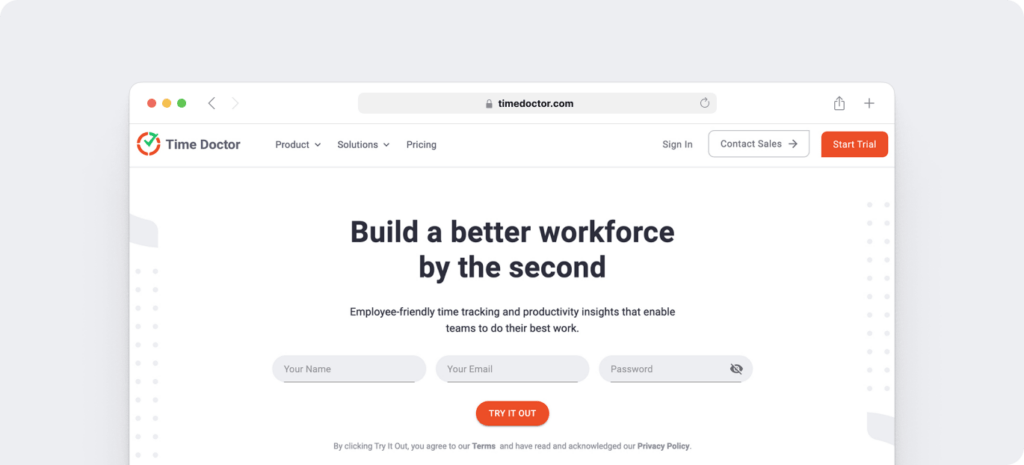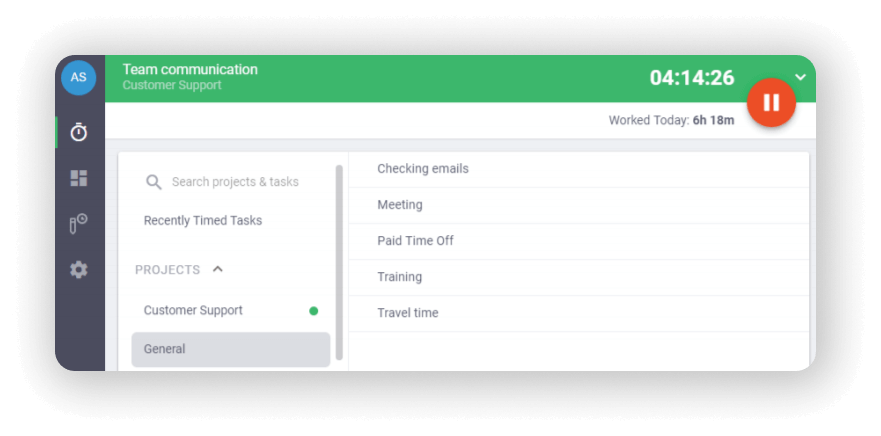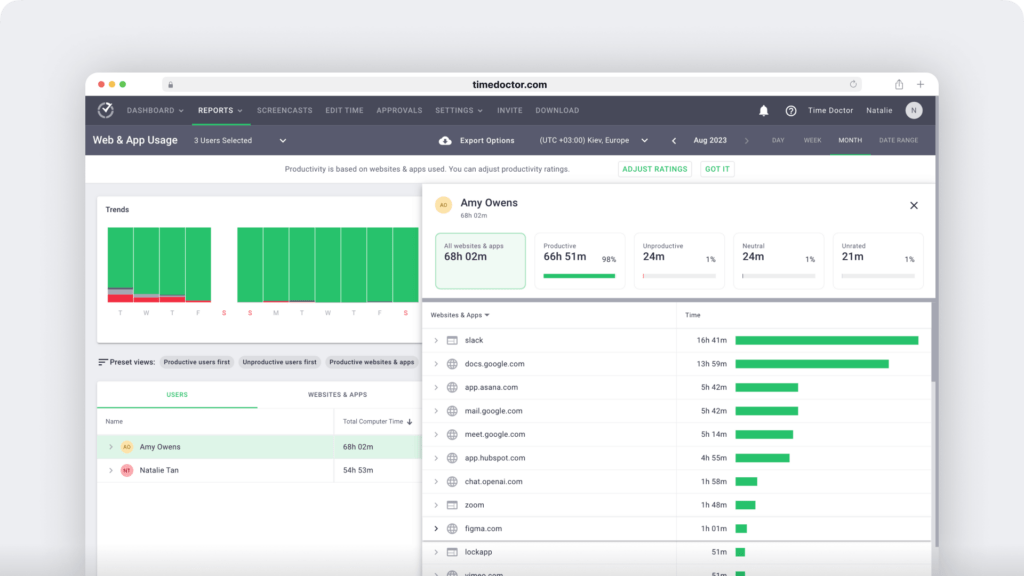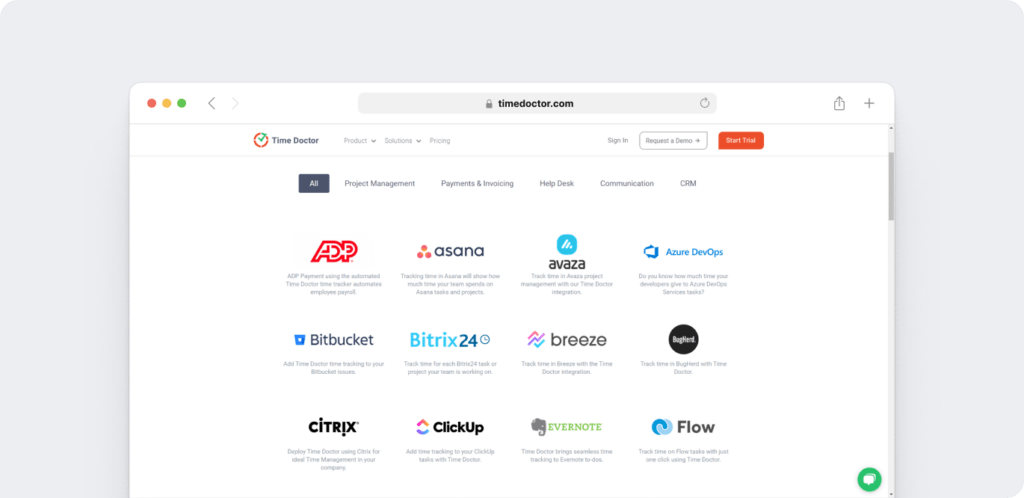Interested in productivity systems?
Humans aren’t always inherently productive. Chances are, every productive person you know has a system in place to help them stay focused on their tasks.
And that’s what productivity systems do.
They help you keep track of priorities so you can decide what to do and when to do it.
But what are productivity systems, and how can you choose the best one for you?
In this article, we’ll tell you exactly what productivity systems are. We’ll show you why they are essential and the seven types of productivity systems you can use.
We’ll also give you tips on picking the perfect productivity system for your business and highlight the best software to use in tandem with your system.
This Article Contains:
(Click on the link below to go to a section of your choice)
- What is a Productivity System?
- Why Are Productivity Systems Important?
- 7 Types of Productivity Systems
- How To Choose A Suitable Productivity System
- Choosing The Best Software To Complement Your Productivity System
Let’s jump in.
What is a productivity system?
Many people confuse the term productivity system with productivity software.
However, a productivity system is actually a set of guidelines, practices, or a productivity method that help people get work done.
It could be a simple method like a to-do list or something more complex like the Kanban approach.
While most organizations have structured productivity systems in place, they’re flexible and easily scalable to support expansion. You can also complement your productivity system with productivity software based on your organization’s needs.
Why are productivity systems important?
With several distractions out there today, remaining focused on tasks can be more challenging than ever. For example, text or social media notifications can quickly distract people.
Fortunately, using productivity systems can help you focus on work and minimize distractions.
A study conducted by the University of California found that when an individual is interrupted from a specific task, it takes an average of 23 minutes for them to get back on track.
So, if you’re continuously distracted at work, you could lose a lot of productive time.
And while being productive isn’t easy, it’s certainly a lot harder when you try to remain productive by yourself.
That’s why productivity systems are essential. They have methodologies to help you avoid streaks of unproductivity, maintain time management and execute everything you set out to do.
7 types of productivity systems
Let’s take a look at some of the most popular productivity systems so you can decide on the best productivity system for your organization:
1. To-do list
The to-do list is the most straightforward productivity system for prioritizing tasks. It requires minimal effort, and you can decide whether to use a manual or digital to-do list, like Todoist.
Many other productivity frameworks are based on the to-do list, and you can find several variations of the to-do list itself.
For example, the Ivy Lee method is a simple yet effective variation of the to-do list that helps people with goal setting and prioritization.
Here’s how you can start a to-do list:
- Writing down all the tasks you have to complete on a piece of paper.
- Sort the tasks according to priorities.
- Start executing tasks one after the other.
- Cross off completed tasks and keep adding new tasks to your list.
2. Getting Things Done (GTD)
Getting Things Done is a productivity system first introduced by David Allen.
The GTD workflow includes a five step process:
- Capture – Write down everything that crosses your mind.
- Clarify – Convert your thoughts into actionable items.
- Organize – Prioritize tasks based on urgency and importance.
- Reflect – Go through the task list to add/remove and adjust tasks.
- Engage – Start executing your tasks one-by-one and complete them.
Sounds like a lot of work?
Well, the GTD system also has six Horizons of Focus to help you easily prioritize tasks.
The Horizon of Focus method breaks tasks down into six areas (or horizons):
- Current actions.
- Current projects.
- Areas of focus and responsibilities.
- 1-2 year goals.
- Long term visions.
- Life goals.
Once you separate everything according to the Horizon of Focus, you’ll be able to prioritize and take action on tasks that need urgent attention while putting the rest off for later. This way, you can focus and clear out tasks one-by-one.
3. The Pomodoro technique
Having trouble focusing on tasks for long periods?
The Pomodoro technique could be just the system for you!
Invented by Francesco Cirillo, Pomodoro is a productivity system that allows people to focus on tasks using short time sprints.
For example, you can work uninterrupted on a task for 25 minutes. The next step is to take a five or ten minute break before jumping into the next thing on your list.
You can also use different methods of the Pomodoro technique like time blocking. Time blocking allows you to focus on a single task during blocks of time broken into 30-90 minutes.
Using Pomodoro and time blocking techniques help minimize distractions and gives users more control over how their workday will go.
4. Zen to Done (ZTD)
Introduced by Leo Babauta, Zen to Done is a technique based on the GTD productivity system. It’s an excellent system for knowledge workers.
However, there are several notable differences between ZTD and the GTD system.
For example, GTD focuses on the productivity system’s effectiveness as a whole. In contrast, ZTD prioritizes personal development and improving one user habit at a time.
Another difference between ZTD and the GTD system is their approach to tasks.
ZTD also focuses more on clearing individual tasks, while GTD is designed to improve productivity by building a system. GTD focuses on completing everything, whereas ZTD breaks everything down to essential tasks and focuses on finishing those first.
This way, ZTD ensures you don’t get distracted through multitasking.
So, with Zen to Done, you’ll be working on completing around three MITs (Most Important Tasks) per day.
Here’s a breakdown of how ZTD works:
- Write your ideas and daily task list in a notepad or notebook (this will be called your inbox.)
- Take quick decisions regarding items in your inbox without delays.
- Set MITs every day.
- Complete one task at a time without distractions.
- Keep your to-do lists simple and update them daily with new and recurring tasks.
- The next step is to keep everything in its proper place.
- Conduct a weekly review of your system and goals.
- Simplify each goal and task — reduce them to essentials.
- Stick to routines.
- Do work that you’re passionate about.
5. Kanban
Kanban is a productivity system developed by Toyota to achieve greater efficiency during manufacturing.
However, thanks to the Agile framework, many other fields like software development and healthcare use Kanban to improve productivity too.
How does Kanban work?
You can use a digital platform like Trello or Jira, or even a whiteboard and sticky note collection as a personal kanban board.
Write down all your tasks and insert them into categories like:
- To-do
- Work-in-Progress
- In Review
- Completed
You can add or reduce the number of categories to suit your business, but the core principle lies in giving you an overview of the current state of tasks. This way, you’ll know which tasks to prioritize and complete — so you can reduce the number of tasks in progress.
6. Don’t break the chain
Don’t break the chain is a simple system introduced by Jerry Seinfeld. It’s a great personal productivity system for individuals in creative occupations to be more systematic in their work.
Here’s how it works:
- Get a calendar.
- Decide on a daily goal.
- Mark an X over every day you accomplish your goal.
For example, let’s say you’re a freelance writer, and you aim to deliver one article every day of the year. For each day you finish a piece, mark an X on the calendar.
Eventually, you’ll end up with a chain of Xs. Then, all you have to do is not break that chain and carry on the Xs to the next day.
However, it’s normal to miss your goals and due dates sometimes. So, remember to plan for these lapses and accommodate occasional breaks into your schedule.
7. Eat the frog
Eat the frog is a system introduced by Brian Tracy, and it simply gets people to tackle their most important tasks first.
Here’s a simple breakdown of the Eat the Frog method:
- Identify your frog – Figure out your most challenging tasks for the day.
- Eat the frog – The next step is to complete the most challenging or important tasks first.
- Repeat daily – Continuously finishing up the most important task first will give you more time to deal with other smaller tasks.
This can help you reduce procrastination and improve your general mood since you deal with the most demanding tasks first. It’ll also help improve your work quality because you handle critical tasks when you have high energy levels.
How to choose a suitable productivity system
We’ve looked at seven popular productivity systems, but choosing just one out of all these different systems could be challenging.
You can’t know what’s right for you without trying them out, right?
Well, that’s exactly what you have to do.
Just pick a system that you think will fit your needs without dwelling on its pros and cons.
Once you choose a system, try it out for at least 30 days. This is important because you need adequate time to figure out all the pros and cons of implementing the system.
Once you complete the first 30 days, you can decide whether to continue with your current system or move on to another productivity system.
However, remember that your business is different from every other firm. So if you want the best productivity levels — you’ll have to customize your productivity system to fit your business needs’.
Choosing the best software to complement your productivity system
Would your business’ productivity levels suddenly increase after implementing a good productivity system?
Not really.
You need to complement your productivity system with powerful productivity management software. Productivity software can help keep your employees motivated and focused on work while also providing you with critical information to assess personal productivity levels.
And if you’re looking for a productivity software that’s easy to use, affordable, and packs a ton of features, Time Doctor could be perfect for you.
What is Time Doctor?

Time Doctor is a powerful time tracking and employee productivity management software that’s incredibly user-friendly. From large firms to SMBs, companies and teams use Time Doctor to stay motivated throughout their workday.
With Time Doctor, you can:
- Track how long employees spend on work.
- Help your team stay focused at work through idle prevention.
- Access real-time productivity reports.
- Easily integrate with any other productivity tool to increase functionality.
- Manage your payroll directly through the app.
- Use the Time Doctor Chrome extension to track time over several apps with ease.
Now, let’s take a quick look at some of Time Doctor’s best features:
1. Simple and easy time tracking
Most people detest time trackers because they’re so complicated to use.
But that’s not the case with Time Doctor.
Time Doctor has a simple time tracking feature that can help users record work hours without any issues.
If your firm is using the manual/interactive time tracking mode, all a user has to do is:
- Open Time Doctor.
- Type in the task.
- Start the timer.
Time Doctor will then run in the background keeping track of the user’s computer usage. Once the user finishes the task, a single click on the Stop button will stop the timer.

Note: If you want automation in your time tracking option, Time Doctor has an automatic time tracking mode that tracks time whenever the computer is turned on.
2. Reduce distractions and idle time
Are you concerned about employee idle times?
With Time Doctor, you can measure your employees’ idle times down to the second.
Time Doctor can track idle time in idle seconds and idle minutes.
An idle second is one second without any keyboard and mouse activity, while an idle minute is one whole minute without any activity.
You can use this idle time tracker to see if employees perform at their best or need help with being more productive at work. This feature can also prevent employees from intentionally wasting their time on social media.
Note: Time Doctor isn’t a keylogger — it only checks if any buttons were pressed to detect inactivity. It doesn’t store any keystrokes and mouse clicks.
3. Generate productivity reports in real-time
Time Doctor features several productivity reports that can help quickly analyze how productive your employees are in real-time.
Here are the reports you can access with Time Doctor:
- Activity summary report – Shows a summary of all productive and unproductive hours, including mobile time for each user.
- Hours tracked report – Shows the billable hours tracked by an employee.
- Projects & tasks report – Displays the time spent on specific projects and tasks.
- Timeline report – Shows the tasks and breaks logged by a user in chronological order.
- Web & app usage report – Displays all sites and apps used by employees during work hours.

Want to know how you can use these reports to measure your team’s performance?
Read our guide on measuring performance with productivity reports.
4. Powerful integrations
With Time Doctor, you can integrate many productivity tools to streamline your workflow.
You can integrate with apps like Asana, Jira, and ClickUp and track productivity levels across these apps too. Time Doctor. Time Doctor also integrates with tools like Zendesk to help you manage helpdesk activities.

Wrap up
There are different productivity systems and productivity tips that can help you improve workplace productivity.
However, there is no right productivity system that fits every business. The critical part is figuring out which one suits your requirements best.
Try out a new productivity system, make tweaks according to your needs, and stick with it if it gives you the desired results. If you don’t think it’s a good system, you can always try out another system.
Remember to pair up your productivity system with a tool like Time Doctor, and you’ll be well on your way to achieving maximum productivity!

Liam Martin is a serial entrepreneur, co-founder of Time Doctor, Staff.com, and the Running Remote Conference, and author of the Wall Street Journal bestseller, “Running Remote.” He advocates for remote work and helps businesses optimize their remote teams.


